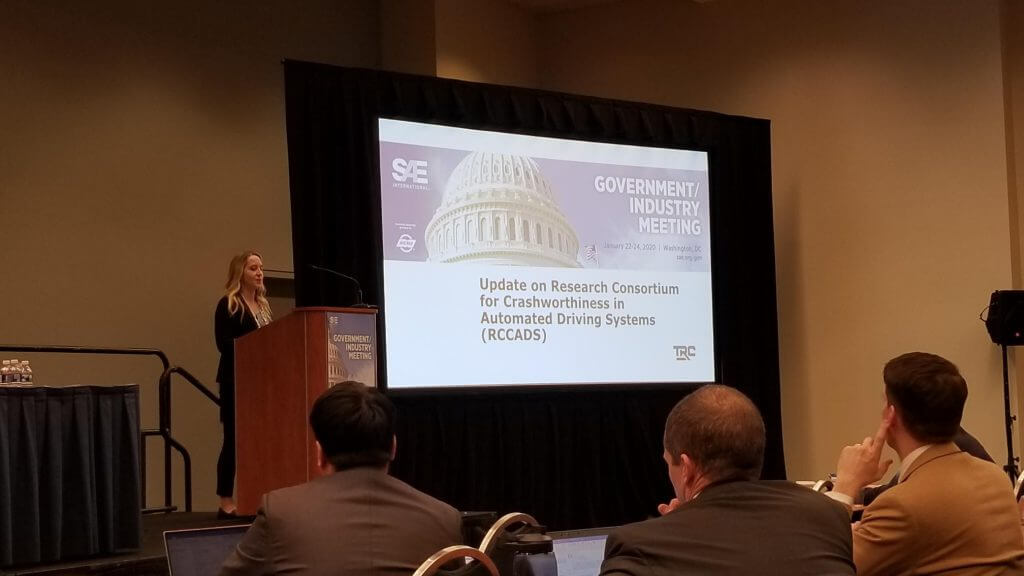News & Events
TRC Inc. forms Research Consortium for Crashworthiness in Automated Driving Systems (RCCADS)
TRC Inc. forms Research Consortium for Crashworthiness in Automated Driving Systems (RCCADS)
Consortium research is aimed at guiding passenger-safety improvements in all phases of automotive design and manufacturing
East Liberty, OHIO (January 2020) -With advanced driver assistance systems fast becoming common in American cars and trucks, and with fully autonomous vehicles soon to come, a new consortium of the U.S. auto industry’s leading car makers and component suppliers is working to provide the research needed to inform the design for occupant safety that these vehicles will require.
The newly formed Research Consortium for Crashworthiness in Automated Driving Systems (RCCADS), with members including public and private sector entities, is led by the Transportation Research Center, Inc. (TRC), North America’s most advanced independent automotive testing facility.

“As automated driving systems continue to evolve and become more common on U.S. roadways, the automotive industry would benefit from a unified approach to help ensure that as vehicles become smarter, they will also be safer,” said Ron Burton, Chief of Staff at TRC. “There’s no question that occupant safety has improved tremendously since the 1970s, thanks to the efforts of the industry, the National Highway Traffic Safety Administration (NHTSA) and several non-government entities,” he said.
“With a long history of continuing safety improvements, the challenge now is to maintain that momentum, because automated driving systems require new thinking about the design of occupant protection systems and other parts of a vehicle’s interior,” Burton said. “Consortium members are working together to generate the research to help ensure that vehicle interiors continue to meet the high standards of occupant safety that have evolved over the past half century.”
According to Burton, RCCADS members are collaborating to first understand what research is underway globally and then to identify gaps in the research that the consortium can fill. The consortium research agenda is centered around providing the biomechanical data that can be used to create guidelines for updating and improving tools and in defining injury risk. As part of this effort, the consortium also seeks to understand the probable realistic future of non-standard seating configurations, restraints, and consumer seating preferences.
“As manufacturers and suppliers have been independently working on their new automated driving technologies, they have also realized that research on the interior of vehicles and passenger safety would benefit from a collaborative approach,” he said.
About RCCADS:
Research Consortium for Crashworthiness in Automated Driving Systems (RCCADS)
TRC is currently and leading a consortium of government agencies, automotive manufacturers, and suppliers to develop a foundation of research to inform the development of safety validation methods and tools for automated vehicles, focusing on occupant protection and crashworthiness. The RCCADS consortium is a collaborative research effort that engages all stakeholders, including industry, government, and academia to help ensure that as vehicles become smarter, they will also be safer. To this end, RCCADS research projects are selected and funded by consortium members and are completed by a pool of qualified research and development institutions, including universities and research and testing companies.
For more information about RCCADS, including how to become a member or how to bid on RCCADS projects, please reach out to:
- Allison Kender (kendera@trcpg.com)
- Ron Burton (burtonr@trcpg.com)
For more information about TRC Inc. contact: info@trcpg.com
Jen Dunn
(937) 407-0888
Recent News & Events
April 17, 2025
Transportation Research Center’s Jen Dunn Named as a Fellow of Leadership Ohio’s Class of 2025
March 31, 2025
For the Third Straight Year, Transportation Research Center Inc. Has Been Named a Top Workplace by Columbus CEO Magazine
December 17, 2024
Transportation Research Center Inc. Expands Cold Weather Testing Capabilities With Addition Of TRC Minnesota